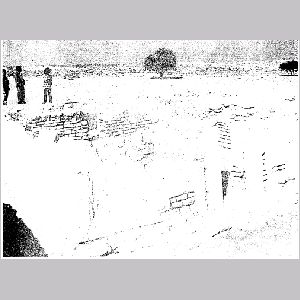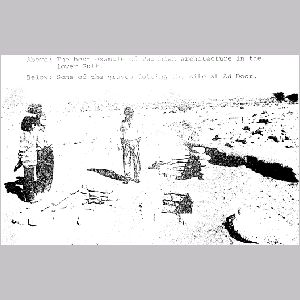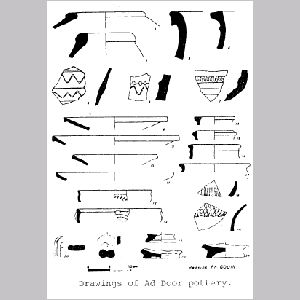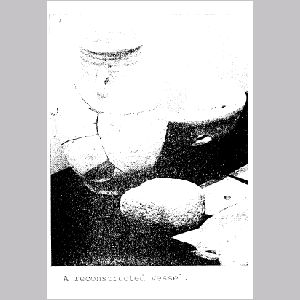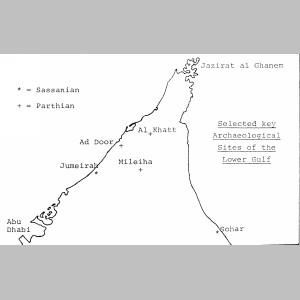Bulletin 34 - March 1988: Archaeology in Umm al Qaiwain
Archaeology in Umm al Qaiwain
by Peter HellyerTwo thousand years ago, the now somnolent emirate of Umm al Qaiwain was the site of one of the most important city states in the whole of the Gulf region, according to leading archaeologists now investigating the area.
The city, believed to cover at least four square kilometres, lies at Ad Door, on the main road to Ras al Khaimah a few kilometres north of the turning to the town of Umm al Qaiwain. Hidden from the coast at khor al Beidha by a range of sand dunes up to 18 metres high, the site was first investigated by an Iraqi team in 1974, who investigated a large building in the centre. For the next twelve years, however, little work was done, and it is only as a result of excavations over the past couple of years by teams from four European universities, working as a joint project, that some real idea of Ad Door’s significance is now being obtained.
According to Professor Ernie Haerinck of the Department for Near Eastern Art and Archaeology in the University of Ghent in Belgium, leader of a team that finished a short campaign on the site in mid-December 1987, it is now clear that from around the first century BC to the third century AD, Ad Door was “a very major site for the period.” The size of the site, together with the finds already made, indicate that “it was a city, not a village,” Haerinck says, describing it as the largest site known from the period on the Arab shores of the Gulf south of the Qatar peninsula.
Coins found on the site by the archaeological teams, and some in the private collection of the Umm al Qaiwain Ruler. His Highness Sheikh Rashid bin Ahmed al Mu’alla show that, like Thaj in Saudi Arabia and Characene on the Shatt al Arab in southern Mesopotamia, Ad Door was issuing its own coinage. One typical coin depicts a seated figure on a throne holding a staff, with an image of the Greek god/hero Heracles, clad in a lion skin, on the obverse. Coins have also been found at Ad Door from characene and further afield, proving involvement in regional trade. According to Haerinck the local mint suggests that Ad Door was not simply a far-flung outlier of the Parthian Empire which then dominated the region but, like Characene, was perhaps instead “a petty kingdom, which made its living through commerce and shipping,” possibly under loose Parthian tutelage.
Haerinck, an expert on the Parthian period, notes that besides the coinage the pottery on the site also indicates that Ad Door was an important trading centre. Excavations in 1987 produced typical east Roman glass, a laro and other items in bronze (again typically east Roman in style), a potsherd from India and masses of green-glazed Parthian ware known from Failaka in Kuwait, Susa in Iran and from southern Mesopotamia, but not known anywhere else in the southern Gulf.
Ad Door seems to have developed in around the first century BC, as the Parthian Empire rose to its peak in what is now Iran. Although it is difficult to make definitive statements, it seems that there was no large town on the southern coast of Iran to act as a staging post for trade from the Indian sub-continent, and Ad Door may well have played this role. The location was ideal for a trading port. The site is sheltered from view by large sand dunes, on top of which the bases of at least four watch-towers can be traced. From here guards could look out to sea, while passing vessels could see nothing of Ad Door itself. Below the dunes on the coastal side a large and sheltered creek, Khor al Beidha, provided a safe anchorage and harbour for commercial shipping.
The site of the city has its own peculiarities. It appears not to have a clearly defined street plan with buildings huddled together. Instead, the buildings are free-standing, stretching over a wide area, with cemeteries not just on the outskirts, but throughout the city. The Ghent team worked on some burials in 1986 and 1987, as did a team from Britain’s Edinburgh University in 1986. The most exciting find for the Haerinck team in the final weeks of 1987, however, was a plastered building covering a precise square of 7.6 metres.
This building, which Haerinck describes as being “typical east Roman rustic architecture”, was a single storey structure with walls surviving to 2.2 metres high, and with two doors opposite each other facing north west and south east. This arrangement would undoubtedly have led to people in the building suffering discomfort from rain and wind, while there are other features which suggest it may not have had a domestic function. There are no windows, while the south east facing door was decorated on either side with plaster. Outside this door there was a plastered doorstep, hardly practical for a residence, and a small squared stone that had been used for a fire. Haerinck declines to speculate on what the building may have been, although he does say it was “not a normal dwelling house”. More recently he has inclined to the view that it may have had a religious function.“ More and more we are convinced that the building … is a temple or shrine in the vicinity of an extensive graveyard.” (Pers. Comm.)
The building is also clearly different from the dwellings that have been excavated on the site, which appear to have had only a single layer of stones, with the walls being built perhaps of barasti or some other perishable material.
One interesting find from the building is a piece of an inscription in Aramaic, a lingua franca in much of the Middle East at the turn of the Christian era. It has not yet been translated, and may be too short to give much information, but it again underlies the existence of trading links between Ad Door and what was then the Fertile Crescent.
The building is only one of the pieces of evidence that the ancient inhabitants of Ad Door were clearly a sophisticated people. The Iraqi team who first worked on the site in 1974 excavated a building surrounded by a courtyard that was itself enclosed by a roughly square wall, with circular watch-towers at each corner, possibly a fort.
In 1986 the British team worked on a graveyard that had two large tombs sunk into the earth and built and paved of finely cut stone, surrounded by a number of smaller and much simpler graves that had perhaps been used for servants of the important personages buried in the two larger ones. Although all of the tombs had been looted in antiquity, in one of the two larger ones was found a number of bronze objects, including a sword.
Haerinck and his colleagues clearly hope that further excavation will turn up the answers to number of key questions that remain about Ad Door. One, for example, is the source of its water supplies. Clearly such a large city would have required ample supplies of fresh water, but no well remains. There are, however, two hollows where there is more vegetation than in other areas and excavations there may provide a solution. Another question is why the city died. It is clear from the surrounding buildings that it was not destroyed, and yet during the third century AD the place was abandoned. There is no sign of any subsequent occupation during the Sassanian period that followed the collapse of the Parthian empire, or during the Islamic era that followed. As Haerinck says, “there is not a single pottery sherd later than the third century AD, and no further evidence of occupation until the drink cans of modern times.” Perhaps the supplies of drinking water dried up, or perhaps he patterns of trade changed, destroying Ad Door’s role as an emporium. During the first century AD the Azd Arab tribes began their move from south western Arabia towards Oman, disrupting local trade. By the late third century the Parthian empire was in decline, under challenge from the upsurge of the Sassanians who were to destroy it. With the region in a state of political chaos, the peace on which commerce thrives would have left Ad Door and its trading partners. By the mid fourth century AD the Sassanian King Shapur the Second was ravaging the Arab side of the Gulf, but by that stage Ad Door was apparently desolate. Why did its people leave, and where did they go? The answers may still lie under the sands.
And then there is also the riddle of city’s name. So far nothing has been uncovered that has enabled archaeologists to identify their site. The coins minted here bear no name, and no inscriptions have been found that would throw light on the subject. Historical texts from the period, such as the ‘Periplus of the Erythrean Sea’, refer to a city of Omana, a prosperous merchant centre inside the Gulf, whose location has not been satisfactorily identified. A number of leading archaeologists have previously placed it on the Iran side of the Gulf, but Haerinck believes the obvious size and importance of Ad Door make it “most reasonable to assume it is a possible candidate.”
Many questions, then, remain to be answered. Sufficient is known, however, to show that it was extremely important. It has now been chosen as the focus of a four-nation programme involving teams from Ghent, Edinburgh, Copenhagen and Lyons, who will jointly share tasks. The Belgian team flew home last December and have been replaced by the Danes and French. The British follow in late April.
Dating back well beyond the two thousand year old site at Ad Door, a host of other sites have recently been located within this small emirate that push the frontiers of its history back more than five thousand years. The oldest sites so far identified date to the fourth millennium BC (4000 – 3000 BC) and have been tentatively linked with the Ubaid culture known elsewhere in Gulf, particularly from the north east coast of Saudi Arabia. One such site has been found within the confines of the Ad Door complex, with flint arrowheads and scrapers being picked up from the surface, though no settlement site has been located so far.
Another site has been discovered on the coast within Umm al Qaiwain town. This was a huge mound composed mostly of shells mixed with carbon, indicating the presence of a people who cooked and ate locally-collected shellfish. This site is one of the oldest known from the Emirates and may be contemporaneous with similar mounds on the coast just south of Jazirat al Hamra a few miles north. The size of the Umm al Qawain mound indicates a lengthy occupation period; flint artefacts were also found here. Unfortunately a large part of the mound was removed in ignorance by bulldozers to make a new garden for Umm al Qaiwain’s Crown Prince Sheikh Saud bin Rashid al Mu’alla, although part of it remains. Sheikh Saud and the government of the emirate are now aware of the danger of construction work obliterating the national heritage and orders have been given to ensure that such accidents do not recur.
The planned emirate-wide survey should lead to a record of sites for preservation, and it is likely that other shell mounds will turn up along the coast.
From the fourth millennium the ancient history of the emirate moves forward to the third. A site from this period has been located, again simply by surface examination, very close to the major Parthian building at Ad Door described above. The site may be contemporaneous with that at Umm al Nar, just outside Abu Dhabi, Haerinck suggests. At that time, according to Umm an Nar evidence, the camel would already seem to have been domesticated, permitting transport across lengthy land distances, while sea-borne trade in the Gulf and across to the Indian sub-continent was well-established. So far the Ad Door third millenium site has not been excavated, and despite a cursory surface search, no evidence has yet been found of another site of the same period at Umm al Qaiwain’s inland oasis of Falaj al Mu’alla. This would almost certainly have been on any trade route linking that from Ras al Khaimah along the edge of the Hajar Mountains through Dhaid and Mileiha to Al Ain and away to Sohar on the Omani coast. It is hoped that the emirate-wide survey will produce fresh evidence.
The second millennium remains by and large a mystery through-out the UAE, with an unexplained gap of several hundred years during which nearly all of the major sites, including ones like those at Al Ain which were otherwise occupied for thousands of years, have yet to yield up their secrets. Umm al Qaiwain, it seems, fits into this general pattern. Haerinck, at least, has no evidence from the coast or from Falaj al Mu’alla to suggest that things were any different.
It was not until the late second millennium, not long before about 1000 BC, that some degree of prosperity seems to have returned to the region, judging by the available evidence. This period marked the arrival of iron in the area and the consequent socio-economic blossoming of the so-called local Iron Age, which lasted well into the first millenium.
Two major Middle Iron Age sites have been located in Umm al Qaiwain, dating from around 800 – 600 BC. One, yet again, is at Ad Door, covering a large area immediately to the north east of the main building site. Initial work has indicated the presence of a cemetery and a settlement site, though a full investigation has yet to be undertaken.
The other site is at Tel Abraq, not far from the junction between the UAE’s main coastal highway and the turning to Umm al Qaiwain town. The site represents a large settlement apparently occupied over several hundred years, during which a large mound or ‘tel’ was created. This type of site is common in Mesopotamia but rare in the southern Gulf, although a smaller tell exists at Khatt near Ras al Khaimah Airport, dated to around the same period.
The site was a major settlement according to Haerinck, but still has to be investigated below surface level. One edge has been damaged by construction work but sufficient remains to provide work for several archaeological seasons. Just as Al Ain has provided a fairly detailed chronology of the local Iron Age, it is hoped that various sites will, in time, give us similarly detailed information about this period in Umm al Qaiwain.
The Iron Age is followed in some other parts of the Emirates by a Hellenistic period. One well known site is at Mileiha in Sharjah Emirate. So far, no Hellenistic have been found in Umm al Qaiwain.
The next major period was the Parthian era, from the first to the third centuries AD, during which Ad Door rose, flourished and died. But Ad Door is not the only site of that period.
According to Haerinck, another has been located on the off-shore island of Sinaiya, and tentatively dated to same period. The site has burial mounds, while the emirat’s Ruler sheikh Rashid bin Ahmed al Mu’alla has coins in his private collection from Sinaiya that apparently originate from the Ad Door mint. Much work needs to be done but, unlike some other sites in the emirate, Sinaiya should remain undisturbed. Privately owned by the Ruler, it is a wild-life reserve and an important breeding site for birds.
The Ad Door city of the Parthian era may be the most significant part of Umm al Qaiwain ‘s history – though who can tell until all the sites are fully investigated. Stretching back perhaps four thousand years into the past, however, it is clear that the area holds secrets that can throw much light on the development of civilisation in this part of the Gulf.
